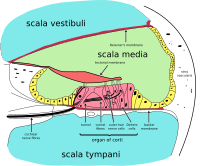
Photo from wikipedia
Capillary pericytes in the cochlea of mammals are-compared to pericytes in other tissues, like the CNS-relatively poorly researched. To begin with, there is still a considerable debate as to whether… Click to show full abstract
Capillary pericytes in the cochlea of mammals are-compared to pericytes in other tissues, like the CNS-relatively poorly researched. To begin with, there is still a considerable debate as to whether the very last precapillary arterioles should-due to their contractile properties-may be considered to be pericytes.However, cochlear capillary pericytes have shifted into the center of attention in the past decade. Most mammals show a considerable number of pericytes in the stria vascularis of the cochlea-up to 1300 in a mouse alone. This high number may be explained by the observation that cochlear capillary pericytes may be differentiated into different subgroups, depending on the immune markers that are expressed by them. Corresponding with these subpopulations, cochlear pericytes fulfill three core functions in the physiology of the cochlea: Formation of the intrastrial blood-fluid barrier-Pericytes monitor the ion, fluid, and nutrient household and aid in the homeostasis thereof. Regulation of cochlear blood flow-By contraction on relaxation, pericytes contribute to the regulation of cochlear blood flow, a paramount function parameter of the cochlea. Immune response-Pericytes actually contribute to the immune response in inflammation of the cochlea. Due to these central roles in the physiology of the cochlea, pericytes actually play a major role in numerous cochlear pathologies, including, but not limited to, sudden sensorineural hearing loss, acoustic trauma, and inflammation of the cochlea.
Journal Title: Advances in experimental medicine and biology
Year Published: 2019
Link to full text (if available)
Share on Social Media: Sign Up to like & get
recommendations!